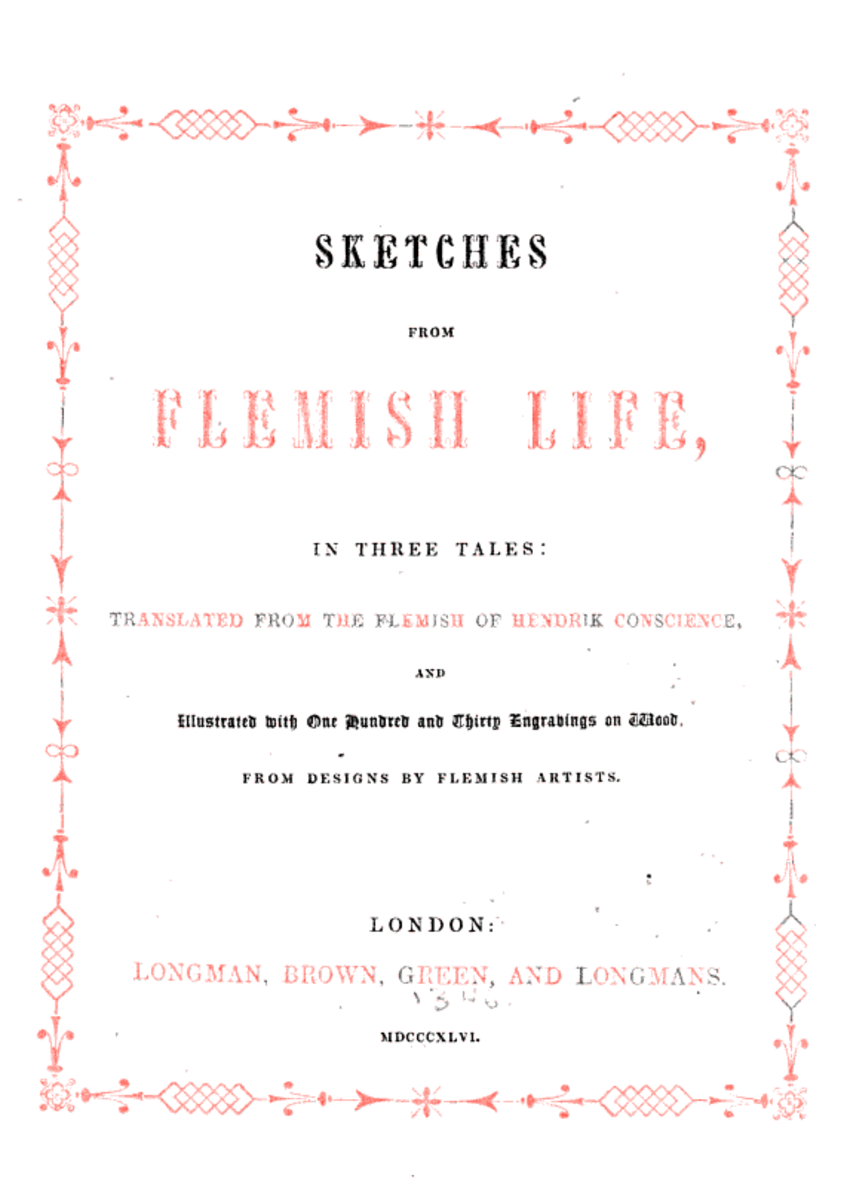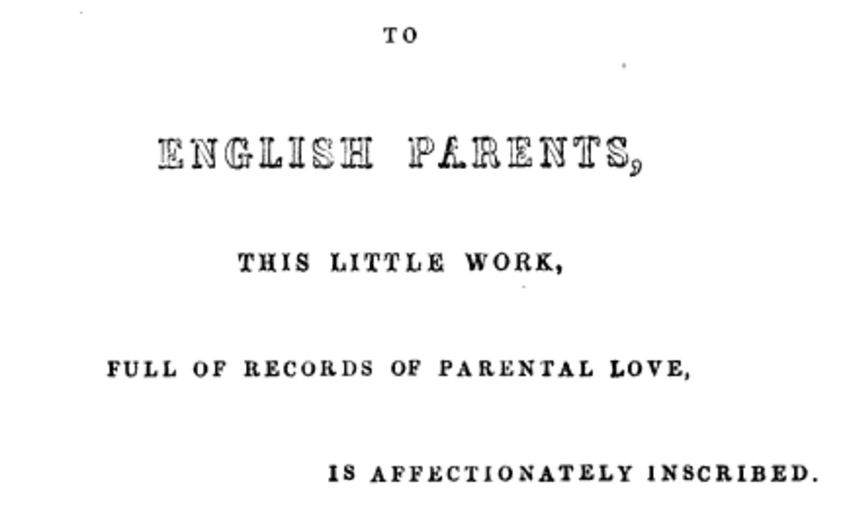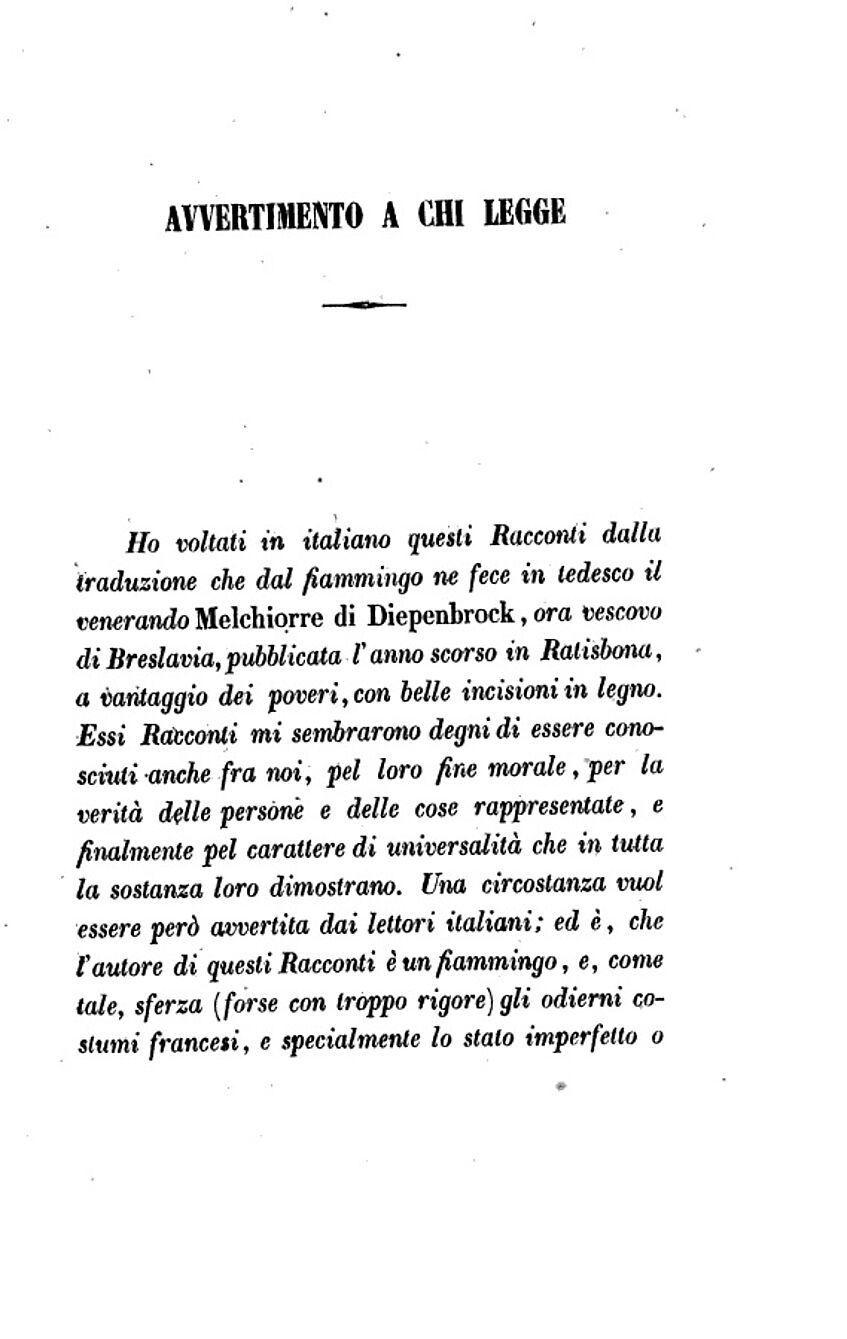Afterlife
Front page of Sketches from Flemish Life (London 1846)
Book dedication in Sketches from Flemish Life (London 1846)
First page of Gar's "warning to the reader" in Vita domestica dei Fiamminghi (Florence 1846)
Afterlife
Flämisches Stillleben was translated into several other languages. Only one year after its first edition was published, translations appeared in Italian (Vita domestica dei fiamminghi descritta in tre racconti, 1846) and in English (Sketches from Flemish Life, 1846). Sketches from Flemish Life was republished for the American market in 1849 under the title Tales of Flemish Life. Later on, translations into Swedish (Flämiskt stillif, 1854) and Hungarian (Flam csöndélet, három kis elbeszélésben, 1858) would follow. The Czech translations of Siska van Roosemael (Siska van Rosemal. Pravdivé příběhy panny dosud žijící) and Wat eene moeder lijden kan (Co matka snésti může. Prawdivá událost z tiché domácnosti flémské), which were published in 1846 as feuilletons in literary magazines, are also based upon Von Diepenbrock’s translation (Engelbrecht 243–44).
Although these translations are all based upon the same source text, there are major differences in the way Conscience’s stories are presented to the audience. The English translation by Nicholas Trübner, for example, is dedicated to “English parents”, and as such indirectly profiles itself as children’s literature. Moreover, its front page suggests a proximity to the Flemish original, claiming that Sketches from Flemish Life is translated “from the Flemish of Hendrik Conscience” and illustrated with “One Hundred and Thirty Engravings on Wood, from Designs by Flemish Artists” (Hendrik Conscience, Sketches from Flemish Life, in Three Tales.).
In reality, Trübner’s translation was based upon Flämisches Stillleben (Calis 301). His introduction, too, broadly follows the preface to the German edition. Trübner integrates the same quotes from the Allgemeine Zeitung and from Conscience’s letter to Von Diepenbrock. He also refers to “the common voice of the Flemish and German people” (Tr. xv) to legitimize his introduction of Conscience’s tales to the English public. Like Von Diepenbrock, Trübner implies a cultural affinity between his own audience and the Flemish. He describes the latter as “a people akin to the English, and still having, in language and feelings, much in common with them” (ibid.). At the same time, he emphasizes the anti-French stance of Conscience, who is introduced as bearing “a glowing hatred to the French refinement and language, which have kept his beloved country in disgraceful subserviency and mental bondage” (Tr. x).
Contrary to Sketches from Flemish Life, the Italian translation, published together with a novella by Heinrich Zschokke, openly refers to Von Diepenbrock’s translations as its source text. Translator Tommaso Gar also points to other German translations of Conscience’s works as an indication of his literary reputation. Instead of a preface, the Italian translation is preceded by a warning to the readers ("Avvertimento a chi legge"), in which Gar prepares his readers for Conscience’s hostile attitude towards France, whose culture and politics were seen as a role model rather than a threat in nineteenth-century Italy. He explains Conscience’s “exaggeration” by referring to his nationalist motives, which he presents as an example for Italian readers (Dagnino 338–39).
Select Bibliography
Calis, Koen. Meer melk dan vlees? Sporen van Hendrik Conscience in Engeland en Amerika. Vol. 123, no. 2–3, 2013, pp. 297–319.
Dagnino, Roberto. “Een genoeglijk avontuur. De Italiaanse vertalingen van ‘Enrico’ Conscience (1846-1967).” Hendrik de Veroveraar: de wereld van Conscience, Conscience in de wereld (1812-2012), edited by Piet Couttenier and Walter Verschueren, Koninklijke Academie voor Taal- en Letterkunde, 2013, pp. 335–266.
Diepenbrock von, Melchior, translator. “Vorrede.” Flämisches Stillleben, in Drei Kleinen Erzählungen, 2nd ed., Friedrich Pustet, 1845, pp. VII–XIV.
Engelbrecht, Wilken. “De Tsjechische Conscience.” De Grote Onleesbare. Hendrik Conscience Herdacht., edited by Kris Humbeeck et al., Academia Press, 2016, pp. 239–64.
Gar, Tommaso. “Avvertimento a chi legge.” Vita domestica dei fiamminghi descritta in tre racconti da Enrico Conscience, Poligrafia italiana, 1846, pp. 7–8.
Gera, Judit. “Een Vlaamse leeuw de grenzen voorbij.” Internationale Neerlandistiek, vol. 54, no. 3, 2016, pp. 163–68.
Hermans, Theo. “The Highs and Lows of Hendrik Conscience.” The Low Countries, vol. 22, 2014, pp. 162–68.
Tr., N. “Translator’s Preface.” Sketches from Flemish Life, in Three Tales., Longman, Brown, Green and Longmans, 1846, pp. ix–xvi.



